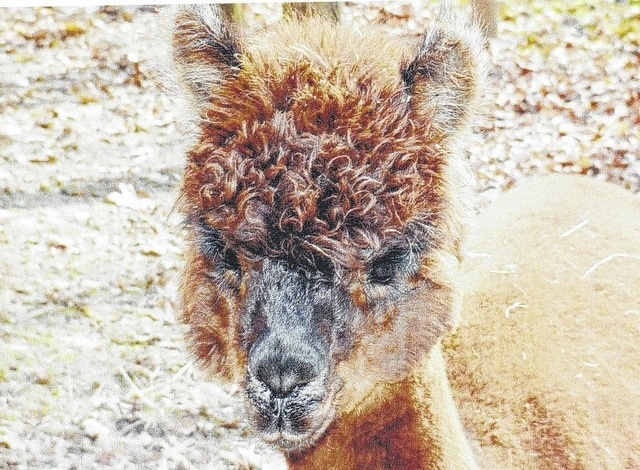
Look for some new features at the 2015 Champaign County Historical Society’s Oktoberfest this year.
This community family affair of food booths, vendors of handmade craft, community information displays, and live entertainment event is held to raise operating funds for the historical society. It is always held the first Sunday in October which will be Sunday, Oct. 4, 2015. The hours for the public are from 10 a.m. to 4 p.m., outside on the lawn of the museum at 809 E. Lawn Ave., Urbana, Ohio. The museum is also available for touring the day of the Oktoberfest.
Admission to the grounds is a bargain at $2 for each adult and youth 10 years of age and over. Children under 10 are free when accompanied by an adult.
One of the new features this year is a live unusual animal display. Fifteen years ago, Susan Millice, now a retired elementary teacher, became fascinated by the alpacas on display at the Champaign County Fair. The alpacas on display belonged to a private owner. Susan thought “they were so odd and so cute at the same time.” Neither she nor her husband had any previous experience with raising animals but those alpacas just kept drawing her back to watch them and inspired her to learn more about them. Susan shared some of what she knows about alpacas in the following article:
“Alpacas, often confused with llamas, were first imported to the United States in 1984. They are native to Peru, Bolivia, and Chile in South America. Alpacas and llamas belong to the camelid family and are known as the humpless camels. Alpacas are smaller than llamas, weighing approximately 130-200 pounds when full grown. Llamas are taller and can weigh 300-400 pounds. Baby alpacas, called crias, can weigh on average of 12-20 pounds at birth.
“Alpacas are raised for their fleece, a soft and lanolin-free fiber often compared to cashmere and is hypoallergenic. The alpacas are sheared once a year in the spring. A luxury fiber is made into many products including hats, scarves, sweaters, mittens, gloves, vests, ponchos, and coats. The fiber can be dyed or remain the natural colors of white, beige, gray, brown or black, and many shades between.
“Alpacas are easy to raise. Five to seven can be raised on one acre of good pastureland. There are many alpaca farms in Ohio as well as being popular in most of the states throughout the United States. They are gentle but shy.”
According to the Ohio Alpaca website, Ohio has more alpacas than any other state in the union as they have adapted very successfully to Ohio’s climate.
Susan and husband Michael Millice, having two children of 4-H age and living in the country with some space for animals, began going to alpaca shows observing and learning even more about these animals as possible 4-H projects for the children and a fun activity for the whole family. They learned that there are two main breeds. The Huacaya have fluffy fleece bodies and the Suri have more long silky pencil-like locks, resembling dreadlocks but without matted fibers. The females carry their babies for about 345 days. Alpacas are raised for their luxury fiber, for their meat, and as pet, show, and investment animals. They are not bred to be beasts of burden like llamas and their camel cousins. They are social herd loving animals and prefer to live in family groups.
According to Wikipedia, most alpacas do not like being grabbed. Some alpacas tolerate being stroked or petted anywhere on their bodies, although many do not like their feet, lower legs, and especially their abdomen touched or handled. Because of their preference for using a manure pile, some alpacas have been successfully house-trained. An added fact discovered is that alpaca manure makes a great fertilizer for gardens.
The Millice family began with two males and two female Huacaya alpacas and started their own 4-H club to learn and teach others how to raise alpacas in Champaign County. The children have now grown up and the business has been taken over by Susan, who finds great pleasure in caring for their herd of 12 animals. They have had as many as 16 at one time. They sell their fleece in many ways. Some is sold in bulk just as it is sheered from the animal, other is sent to a mill for full processing and into yarn, while some is sold after partial processing and sold to others for their own spinning. When spun into yarn it can be light or heavy in weight, depending on how it is spun. It is a soft and durable, luxurious and silky natural fiber, naturally water-repellent and difficult to ignite. All of these properties make it highly sought after for many purposes.
Come to the 2015 Champaign County Historical Society’s Oktoberfest on Sunday, Oct. 4, from 10 a.m. to 4 p.m., on the lawn of the museum at 809 E. Lawn Ave., Urbana, for a close-up look at a couple of these beautiful animals. Learn even more about these amazing creatures first hand. Susan Millice will also have available for sale, alpaca fiber, yarn, running batts, and finished products such as scarves, cowls, ponchos, socks, headbands, mittens, wrist warmers, and dog sweaters, among other items.


